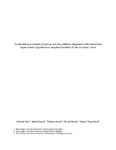| dc.rights.license | In Copyright | en_US |
| dc.creator | Mah, Andrew V. | |
| dc.date.accessioned | 2018-05-02T14:53:17Z | |
| dc.date.available | 2018-05-02T14:53:17Z | |
| dc.date.created | 2018 | |
| dc.identifier | WLURG38_Mah_NEUR_2018 | |
| dc.identifier.uri | http://hdl.handle.net/11021/34112 | |
| dc.description | Thesis; [FULL-TEXT FREELY AVAILABLE ONLINE] | en_US |
| dc.description | Andrew V. Mah is a member of the Class of 2018 of Washington and Lee University. | en_US |
| dc.description.abstract | The purpose of this study is to combine behavioral and computational analyses to describe the
circadian systems of C. turbinata and P. tepidariorum in order to hypothesize adaptive benefits
of the observed behaviors. In the first chapter, I will present a series of numerical experiments
performed on models that recreate C. turbinata's short period circadian clock. The results from
these numerical experiments will be used to give us greater understanding about the nature of
C. turbinata's molecular oscillators and generate testable hypotheses about the adaptive nature
of circadian clocks. In the second chapter, in addition to P. tepidariorum, I will also describe the
circadian systems of two other theridiid species as a point of comparison: the subsocial spider,
Anelosimus studiosus; and the southern black widow, Latrodectus mactans. The goal of these
experiments is to understand the mechanisms underlying the observed variability in spider
circadian systems (e.g., FRP, distribution, and affect of light). More generally, understanding
how this variability arises can improve mechanistic explanations of adaptive benefits. Examining
the free-running behavior, including the FRP and its distribution within a species, of the three
Theridiidae spiders will reveal the behavior of their circadian systems in the absence of any
external cues, because without the influence of external cues, more endogenous traits about the
underlying system become apparent. For example, C. turbinata can entrain its circadian period
to LD 12:12. It is only when the specimens are removed from light that their 19-hour
endogenous period becomes apparent. [From Introduction] | en_US |
| dc.description.statementofresponsibility | Andrew Mah | |
| dc.format.extent | 28 pages | en_US |
| dc.language.iso | en_US | en_US |
| dc.rights | This material is made available for use in research, teaching, and private study, pursuant to U.S. Copyright law. The user assumes full responsibility for any use of the materials, including but not limited to, infringement of copyright and publication rights of reproduced materials. Any materials used should be fully credited with the source. | en_US |
| dc.rights.uri | http://rightsstatements.org/vocab/InC/1.0/ | en_US |
| dc.subject.other | Washington and Lee University -- Honors in Neuroscience | en_US |
| dc.title | Computational Models of Spider Activity Patterns Integrated with Behavioral Experiments Hypothesize Adaptive Benefits of the Circadian Clock (thesis) | en_US |
| dc.type | Text | en_US |
| dcterms.isPartOf | RG38 - Student Papers | |
| dc.rights.holder | Mah, Andrew V. | |
| dc.subject.fast | Spiders -- Behavior | en_US |
| dc.subject.fast | Research | en_US |
| dc.subject.fast | Circadian rhythms -- Mathematical models | en_US |
| dc.subject.fast | Adaptation (Biology) -- Mathematical models | en_US |
| local.department | Neuroscience | en_US |
| local.scholarshiptype | Honors Thesis | en_US |
